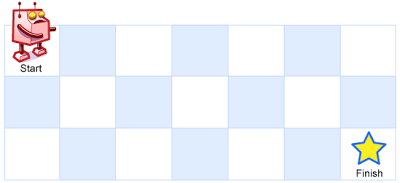4/16/24About 2 min
I Problem
There is a robot on an m x n grid. The robot is initially located at the top-left corner (i.e., grid[0][0]). The robot tries to move to the bottom-right corner (i.e., grid[m - 1][n - 1]). The robot can only move either down or right at any point in time.
Given the two integers m and n, return the number of possible unique paths that the robot can take to reach the bottom-right corner.
The test cases are generated so that the answer will be less than or equal to 2 * 10⁹.
Example 1
Input: m = 3, n = 7
Output: 28
Example 2
Input: m = 3, n = 2
Output: 3
Explanation: From the top-left corner, there are a total of 3 ways to reach the bottom-right corner:
- Right -> Down -> Down
- Down -> Down -> Right
- Down -> Right -> Down
Constraints
1 <= m, n <= 100
Related Topics
- Math
- Dynamic Programming
- Combinatorics
II Solution
Approach 1: Dynamic Programming
Rust
pub fn unique_paths(m: i32, n: i32) -> i32 {
let (m, n) = (m as usize, n as usize);
let mut dp = vec![vec![0; n]; m];
for i in 0..m {
dp[i][0] = 1;
}
for i in 0..n {
dp[0][i] = 1;
}
for i in 1..m {
for j in 1..n {
dp[i][j] = dp[i - 1][j] + dp[i][j - 1];
}
}
dp[m - 1][n - 1]
}Java
public int uniquePaths(int m, int n) {
int[][] dp = new int[m][n];
for (int i = 0; i < m; i++) {
dp[i][0] = 1;
}
for (int i = 0; i < n; i++) {
dp[0][i] = 1;
}
for (int i = 1; i < m; i++) {
for (int j = 1; j < n; j++) {
dp[i][j] = dp[i - 1][j] + dp[i][j - 1];
}
}
return dp[m - 1][n - 1];
}Go
func uniquePaths(m int, n int) int {
f := make([][]int, m)
for i := range f {
f[i] = make([]int, n)
}
for i := 0; i < m; i++ {
f[i][0] = 1
}
for i := 0; i < n; i++ {
f[0][i] = 1
}
for i := 1; i < m; i++ {
for j := 1; j < n; j++ {
f[i][j] = f[i-1][j] + f[i][j-1]
}
}
return f[m-1][n-1]
}Approach 2: Optimized Dynamic Programming
Rust
pub fn unique_paths(m: i32, n: i32) -> i32 {
let n = n as usize;
let mut dp = vec![1; n];
for _ in 1..m {
for j in 1..n {
dp[j] += dp[j - 1];
}
}
dp[n - 1]
}Java
public int uniquePaths(int m, int n) {
int[] dp = new int[n];
Arrays.fill(dp, 1);
for (int i = 1; i < m; i++) {
for (int j = 1; j < n; j++) {
dp[j] += dp[j - 1];
}
}
return dp[n - 1];
}Go
func uniquePaths(m int, n int) int {
f := make([]int, n)
for i := 0; i < n; i++ {
f[i] = 1
}
for i := 1; i < m; i++ {
for j := 1; j < n; j++ {
f[j] += f[j-1]
}
}
return f[n-1]
}Approach 3: Combinatorics
Rust
pub fn unique_paths(m: i32, n: i32) -> i32 {
let m = m as i64;
let mut res = 1_i64;
let (mut x, mut y) = (n as i64, 1);
while y < m {
res = res * x / y;
(x, y) = (x + 1, y + 1);
}
res as i32
}Java
public int uniquePaths(int m, int n) {
long res = 1;
for (int x = n, y = 1; y < m; x++, y++) {
res = res * x / y;
}
return (int) res;
}Go
func uniquePaths(m int, n int) int {
res := 1
for x, y := n, 1; y < m; x, y = x+1, y+1 {
res = res * x / y
}
return res
}